What will be the Cost of Developing a Resume Builder Application?
In today’s competitive job market, a compelling resume can make all the difference. As the world becomes increasingly digital, the demand for efficient tools, such as resume builder applications, has surged. But what goes into creating such an application? What factors affect its development cost? This comprehensive guide aims to answer these questions and provide insights into the intricate process of developing a resume builder application. Whether you’re an entrepreneur exploring this venture or a curious individual, buckle up as we navigate through the realm of app development costs and considerations.
What will be the Cost of Developing a Resume Builder Application?
Developing a resume builder application involves a multitude of factors that collectively determine the overall cost. Let’s delve into the essential aspects that impact the financial investment in creating such an app.
1. Features and Functionality
The complexity of features and functionality greatly influences the cost of your resume builder app. Basic features include template selection, formatting options, and text input fields. However, incorporating advanced capabilities like AI-driven content suggestions, industry-specific templates, and personalized tips can elevate both the app’s value and its development cost.
2. Design and User Experience (UX)
A user-friendly and visually appealing design is crucial for any successful app. Investing in a well-designed interface, intuitive navigation, and responsive layouts ensures an engaging user experience. The cost varies based on the intricacy of design elements, animations, and overall aesthetics.
3. Development Platform
Choosing the right platform for your app—iOS, Android, or cross-platform—impacts both cost and reach. Native apps tailored to a specific platform often require higher development costs. On the other hand, cross-platform frameworks like React Native or Flutter offer cost-effective alternatives while maintaining quality.
4. Technology Stack
The technology stack you choose, including programming languages, frameworks, and libraries, plays a significant role in determining the app’s performance and scalability. Opting for cutting-edge technologies might elevate the cost, but it can also future-proof your app.
5. Backend Development
The backend of your app powers its functionality, user data storage, and seamless synchronization. Complex backend systems, such as user accounts, cloud storage, and analytics, contribute to the app’s cost. Consider whether to build from scratch or utilize existing backend-as-a-service (BaaS) solutions.
6. Third-Party Integrations
Integrating third-party services, such as social media logins, payment gateways, and analytics tools, enhances your app’s capabilities. While these integrations save development time, they can also add to the cost due to licensing fees and customization requirements.
7. Testing and Quality Assurance
Thorough testing is indispensable to ensure your app functions flawlessly across devices and scenarios. Quality assurance processes, including manual and automated testing, bug fixing, and performance optimization, contribute to the overall cost.
8. Security Features
Given the sensitive nature of resume data, robust security measures are non-negotiable. Incorporating encryption, secure authentication methods, and data protection protocols increases the development cost but is essential to gain users’ trust.
9. Maintenance and Updates
After launching the app, ongoing maintenance and updates are essential to keep it relevant and bug-free. Regular updates for operating system compatibility, feature enhancements, and security patches are long-term investments.
10. Legal and Compliance
Addressing legal aspects such as data privacy regulations (e.g., GDPR), terms of use, and intellectual property rights is crucial. Legal consultations and compliance efforts add to the overall cost.
FAQs
How can I estimate the initial cost of development?
Estimating the initial cost involves considering factors like features, platform, and complexity. Consulting with app development experts can provide a clearer picture.
Are cross-platform apps cost-effective?
Yes, cross-platform frameworks can reduce development costs by allowing code-sharing across platforms, optimizing time and resources.
Is it worth investing in advanced AI features?
Investing in AI can enhance user experience and app value. Evaluate its impact on user engagement and ROI before deciding.
How can I ensure data security?
Prioritize security measures, including encryption, secure authentication, and compliance with data protection regulations.
What’s the typical maintenance cost?
Maintenance costs vary but typically range from 15% to 20% of the initial development cost. Regular updates are essential to app longevity.
How do legal factors impact the cost?
Addressing legal factors like data privacy compliance and intellectual property protection requires legal consultations, contributing to the overall cost.
Conclusion
Creating a resume builder application is an exciting venture that involves a multitude of decisions. The cost of development is a composite outcome of features, design, technology, security, and ongoing maintenance. By navigating the intricacies of each factor, you can strike a balance between cost-effectiveness and a compelling user experience. Remember, investing wisely in your app’s development lays the foundation for its success in a competitive digital landscape.
So, are you ready to embark on the journey of creating your own resume builder application? By understanding the key considerations and costs involved, you’re better equipped to make informed decisions that will shape the future of your app.





